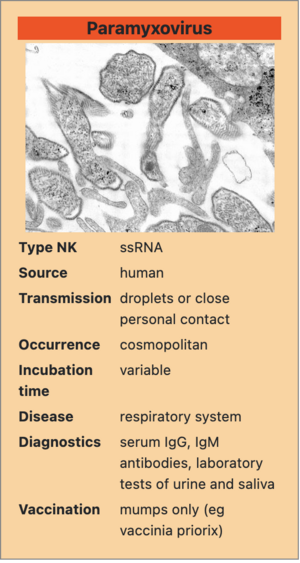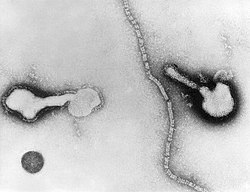Paramyxovirus
Template:Infobox - virus Paramyxovirus is a genus belonging to the family Paramyxoviridae and strain ss RNA enveloped viruses. This genus includes 2 species of viruses infecting humans and one species of virus transmissible only to animals. Human viruses include parainfluenza viruses, which are also transmissible to animals, and mumps virus or epidemic parotid virus. It is one of the purely animal viruses Newcastle disease virus.
Viruses transmissible to humans[edit | edit source]
Parainfluenza viruses[edit | edit source]
Infection parainfluenza viruses can cause both mild respiratory illnesses and potentially life threatening conditions. These viruses make up 40% of respiratory diseases in preschool children. The most serious is this disease for children under 2 years. The disease spreads by droplet transmission and multiplies primarily in the nasal mucosa and nasopharynx, where it replicates and subsequently leads to destruction and inflammatory infiltration of the nasopharynx. Incubation period is about 2-3 days. The infection manifests itself first of fevers accompanied by [rhinitis] and pharyngitis or as laryngotracheitis, bronchitis, bronchopneumonia. Temporary protection against parainfluenza viruses consists of IgA antibodies, so-called mucosal antibodies. There is no other treatment in the form of a chemotherapeutic or vaccine.
Mumps virus[edit | edit source]
Virus Mumps it only attacks humans. It is spread by droplet transmission and the primary center of virus multiplication is the nasopharyngeal mucosa. The virus further spreads to the cervical nodes and from there to other tissues. Eventually, the virus infects the salivary glands, endocrine glands and meninges. The incubation period lasts approximately 2-3 weeks. Then there is swelling of the parotid glands (unilateral and bilateral) accompanied by temperatures. Among the common complication include orchitis, pancreatitis or aseptic meningitis. Several other organs can also be affected (ovaries, mammary glands, thyroid gland ...). Swollen glands may not always occur, sometimes only other symptoms appear. The virus can be identified by both urine and saliva laboratory tests (the virus does not appear in the urine earlier than 10 days after the onset of the disease) or by blood serum on detection of antibodies IgM. In the Czech Republic, children are vaccinated against mumps, usually in combination with a vaccine against measles and rubella.
Viruses transmissible to animals[edit | edit source]
Newcastle disease virus it most often attacks poultry, pigeons, parrots and other birds. However, transmission to humans is also possible. People infected with this virus have symptoms like influenza. The incubation period usually lasts about 14 days. This virus causes the production of humoral antibodies, which can be detected from blood serum.
Links[edit | edit source]
Related Articles[edit | edit source]
External links[edit | edit source]
References[edit | edit source]
- BEDNÁŘ, Marek – FRAŇKOVÁ, Věra – SCHINDLER, Jiří. Lekářská mikrobiologie : Bakteriologie, virologie, parazitologie. - edition. 1996. 558 pp. ISBN 9788023802979.



